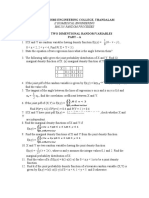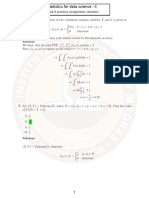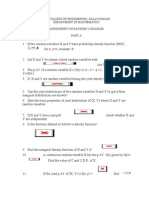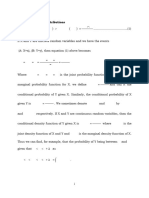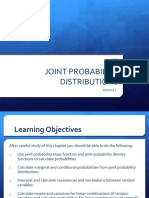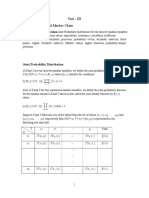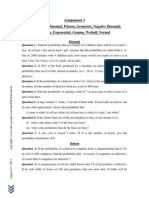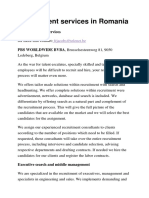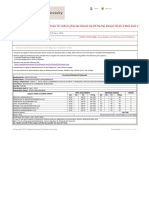Probability Assignment 4
Uploaded by
Vijay KumarProbability Assignment 4
Uploaded by
Vijay KumarO
c
t
o
b
e
r
8
,
2
0
1
3
c
o
p
y
r
i
g
h
t
:
w
w
w
.
s
i
t
e
s
.
g
o
o
g
l
e
.
c
o
m
/
s
i
t
e
/
h
u
b
2
e
d
u
c
a
t
i
o
n
Assignment 4
Two Dimensional Random Variables
1. X and Y are two random variables having the joint probability function
( ) ( )
1
f x, y x 2y
27
= + where x and y can assume only the integer values 0, 1
and 2, find the conditional distribution of Y for X=x.
2. If the joint probability density function of (X, Y) is given by
( ) f x, y k, 0 x y 2 = s < s . Find value of k. Also the marginal and conditional
density function.
3. The joint probability density function of a bivariate random variable (X, Y) is
( )
( )
XY
k x y , 0 x 2, 0 y 2
f x, y
0, otherwise
+ < < < <
(i) find k, (ii) Find the marginal probability density function of X and Y,
(iii) Are X and Y independent? (iv) find ( )
X|Y
f x | y and ( )
Y|X
f y| x
(v) Evaluate
1
P 0 y | x 1
2
| |
< < =
|
\ .
4. The joint probability density function of (X,Y) is given by
( )
2
2
XY
x
xy , 0 x 2, 0 y 1
f x, y
8
0, otherwise
+ s s s s
=
Find (i) P(X > 1), (ii) P(X < Y), (iii) ( ) P x y 1 + s
5. If the joint probability density function of random variables X and Y is
( )
( ) x y
XY
e , x 0, y 0
f x, y
0, otherwise
+
> >
=
Find (i) P(X<1), (ii) P(X>Y), (iii) P(X+Y<1)
O
c
t
o
b
e
r
8
,
2
0
1
3
c
o
p
y
r
i
g
h
t
:
w
w
w
.
s
i
t
e
s
.
g
o
o
g
l
e
.
c
o
m
/
s
i
t
e
/
h
u
b
2
e
d
u
c
a
t
i
o
n
6. Two discrete random variables X and Y have the joint probability mass
function given by the following table
Y
X
1 2 3
1 1/12 1/6 1/12
2 1/6 1/4 1/12
3 1/12 1/12 0
Compute
(i)
3
P X
2
| |
s
|
\ .
, (ii) ( ) P XY is even , (iii) Probability that Y is even given that
X is even, (iv) Probability that X is odd given that Y is even,
(v) Probability that X is prime given that Y is odd.
7. If two random variables have the joint density
( )
XY
xy, 0 x 1, 0 y 2
f x, y
0, otherwise
s s s s
=
(i) Find the probability that both random variables will take on values less than 1,
(ii) Find the probability that the sum of the values taken on by the two random
variables will be less than 1,
(iii) Find the marginal densities of the two random variables,
(iv)Find the joint distribution function of the two random variables and the
distribution functions of the individual random variables,
(v) Check whether the two random variables are independent.
Covariance
8. The joint density function of continuous random variables X and Y is
( )
( )
XY
k x y , 0 x 1, 0 y 2
f x, y
0, otherwise
+ < < < <
. Find the value of k and hence
XY
.
9. Let X be a random variable with probability density function
( )
X
1
f x , 1 x 1
2
= s s and let
2
Y X =
Prove that the correlation coefficient between X and Y is zero.
O
c
t
o
b
e
r
8
,
2
0
1
3
c
o
p
y
r
i
g
h
t
:
w
w
w
.
s
i
t
e
s
.
g
o
o
g
l
e
.
c
o
m
/
s
i
t
e
/
h
u
b
2
e
d
u
c
a
t
i
o
n
10. Find (a) the covariance (b) the correlation coefficient of two random variables
X and Y if E(X)=2, E(Y)=3, E(XY)=10, E(X
2
)=9, E(Y
2
)=16.
11. The correlation coefficient of two random variables X and Y is
1
4
while their
variances are 3 and 5. Find the covariance.
Correlation and Regression
12. Given ( )
( ) x y 1
XY
f x, y xe , x 0, y 0
+
= > > . Find the regression curve of Y on X.
13. Find the correlation coefficient and obtain the lines of regression from the
data given below
X 70 63 72 60 66 70 74 65 62 67 65 68
Y 155 150 180 135 156 168 178 160 132 145 139 152
Also find (a) Y when X = 63, (b) X when Y = 168.
14. For the following data with 0.62 = , write down the equations to regression
lines
Marks in
Mathematics Physics
Average 48.4 35.6
S.D. 8.4 10.5
Estimate the marks in Mathematics corresponding to 70 marks in Physics.
Transformation of Random Variable
15. Let X and Y be two independent Uniform random variables over (0, 1). Show
that the random variables ( ) U cos 2 X 2lnY = t and ( ) V sin 2 X 2lnY = t are
independent standard normal random variables.
16. X and Y have the joint probability density function ( )
xy
, x, y 1, 2,3
f x, y 36
0, elsewhere
If U=X+Y and V=X-Y, then obtain the joint probability density function of U
and V.
You might also like
- MA1254 Random Processes :: Unit 3 :: Two Dimensional Random VariablesNo ratings yetMA1254 Random Processes :: Unit 3 :: Two Dimensional Random Variables4 pages
- Name of The Student: Branch: Unit - I (Random Variables) Problems On Discrete & Continuous R.VsNo ratings yetName of The Student: Branch: Unit - I (Random Variables) Problems On Discrete & Continuous R.Vs15 pages
- 22MA402 PRP Important Questions (1).DocxNo ratings yet22MA402 PRP Important Questions (1).Docx5 pages
- II B.Tech I Semester, Supplementary Examinations, May - 2012No ratings yetII B.Tech I Semester, Supplementary Examinations, May - 20128 pages
- Probability Theory and Stochastic ProcessesNo ratings yetProbability Theory and Stochastic Processes8 pages
- UNIT WISE IMPORTATNT UNIVERSITY QUESTIONSNo ratings yetUNIT WISE IMPORTATNT UNIVERSITY QUESTIONS7 pages
- B.Tech (PT) - Mathematics - II YEAR - III SEM - (R) 2012 PDFNo ratings yetB.Tech (PT) - Mathematics - II YEAR - III SEM - (R) 2012 PDF15 pages
- Joint and Conditional Probability DistributionsNo ratings yetJoint and Conditional Probability Distributions52 pages
- SDM_UNIT_3_Joint Probability and Markov ChainNo ratings yetSDM_UNIT_3_Joint Probability and Markov Chain7 pages
- Unit - III Joint Probability Distribution (Full Notes)100% (2)Unit - III Joint Probability Distribution (Full Notes)30 pages
- Chapter 5 Joint Probability Distributions 2No ratings yetChapter 5 Joint Probability Distributions 249 pages
- PTSP Unit-3 Important Questions& AnswersNo ratings yetPTSP Unit-3 Important Questions& Answers36 pages
- Joint Probability Distributions: F X y X y X y X F X y A A A A A A F X F yNo ratings yetJoint Probability Distributions: F X y X y X y X F X y A A A A A A F X F y23 pages
- Mathematics 1St First Order Linear Differential Equations 2Nd Second Order Linear Differential Equations Laplace Fourier Bessel MathematicsFrom EverandMathematics 1St First Order Linear Differential Equations 2Nd Second Order Linear Differential Equations Laplace Fourier Bessel MathematicsNo ratings yet
- Refrigeration and Air Conditioning by S N Sapali100% (6)Refrigeration and Air Conditioning by S N Sapali211 pages
- Prepared by Nesi Zakuta: Dogus University Industial Enginering Faculty100% (1)Prepared by Nesi Zakuta: Dogus University Industial Enginering Faculty24 pages
- The Effect of Synchronous and Asynchronous Participation On Students' Performance in Online Accounting CoursesNo ratings yetThe Effect of Synchronous and Asynchronous Participation On Students' Performance in Online Accounting Courses31 pages
- Analisis Tingkat Kesehatan Bank Dengan Menggunakan Metode Risk Profile, Good Corporate Governance, Earning, Capital (RGEC)No ratings yetAnalisis Tingkat Kesehatan Bank Dengan Menggunakan Metode Risk Profile, Good Corporate Governance, Earning, Capital (RGEC)16 pages
- Lr2170sa 4ah Specification Sheet TranslatedNo ratings yetLr2170sa 4ah Specification Sheet Translated15 pages
- Work Life Balance HCL Tech Shows The Way With EFCNo ratings yetWork Life Balance HCL Tech Shows The Way With EFC1 page
- Basic Technical Mathematics With Calculus 10th Edition by Washington ISBN Solution Manual100% (41)Basic Technical Mathematics With Calculus 10th Edition by Washington ISBN Solution Manual74 pages
- Product Data Sheet: Easylogic Pm1120H P&E THD RS485 CL 1.0No ratings yetProduct Data Sheet: Easylogic Pm1120H P&E THD RS485 CL 1.04 pages
- IEPE (Integrated Electronics Piezo-Electric) - KistlerNo ratings yetIEPE (Integrated Electronics Piezo-Electric) - Kistler2 pages
- Practice Questions & Answers: Made With by SawzeeyyNo ratings yetPractice Questions & Answers: Made With by Sawzeeyy141 pages
- HardieSmart V2.0 Zerolot Design Guide JAN2017No ratings yetHardieSmart V2.0 Zerolot Design Guide JAN201724 pages
- Welcome To Saurashtra University Naimish Sem 4 BcomNo ratings yetWelcome To Saurashtra University Naimish Sem 4 Bcom1 page
- WWW Who Int/workforcealliance/knowledge/toolkit/33 PDFNo ratings yetWWW Who Int/workforcealliance/knowledge/toolkit/33 PDF1 page


